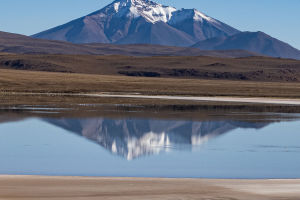Lakes are essential components of the water cycle, often forming as a result of the convergence of surface water in depressions.
Their formation can be attributed to various factors, leading to a diverse array of lake types.
These include sea track lakes, tectonic lakes, crater lakes, glacial lakes, weir lakes, karst lakes, river track lakes, wind-formed lakes, and artificial lakes. Furthermore, lakes can be categorized based on the salinity of their water, with freshwater and brackish water lakes being the two main classifications.
Freshwater lakes are those with non-saline water and typically have both inflowing and outflowing water. This continuous exchange prevents salt accumulation, maintaining the lake's freshwater status. In contrast, brackish water lakes form when water inflows into the lake but lacks outflow, leading to salt accumulation over time.
One of the most remarkable examples of a high-altitude freshwater lake is Lake Titicaca, located in the Andes region of South America. Despite being nestled in the Andean mountain range rather than on the Tibetan plateau often referred to as the "roof of the world," Lake Titicaca stands as the highest altitude freshwater lake globally.
Situated approximately 3,821 meters above sea level, Lake Titicaca boasts an expansive area of around 8,300 square kilometers. Second in size only to Lake Maracaibo and Patuxent Lagoon, Lake Titicaca reaches impressive depths, averaging between 140 to 180 meters, with its deepest point plunging to 280 meters.
The lake's formation is attributed to tectonic activity, arising from the collision and extrusion of the American and Antarctic plates, resulting in the Andean mountain range—the world's longest land mountain range.
Lake Titicaca presents unique characteristics, earning it the distinction of being "high altitude but not frozen, inland but not salty." Despite its lofty elevation, the lake remains unfrozen throughout the year, thanks to its considerable size and depth.
Positioned within low-latitude tropical areas and shielded from cold air by surrounding mountains, the lake maintains an average water temperature of approximately 13 degrees Celsius.
In the vicinity of Lake Titicaca, the Desaguadero River plays a crucial role in maintaining the lake's freshwater status. While most rivers in the area flow into the lake, the Desaguadero River serves as its outlet, carrying salt away from the lake and ensuring its water remains fresh.
Lake Titicaca's significance extends beyond its natural beauty, serving as a vital resource for the communities inhabiting its shores. Its waters support diverse ecosystems and sustain local livelihoods through fishing, agriculture, and tourism.
Moreover, the lake holds cultural and historical significance, with ancient civilizations such as the Incas and Tiwanaku leaving their mark on its shores.
Lake Titicaca exemplifies the diverse and dynamic nature of lakes worldwide. From its formation amidst tectonic activity to its role as a life-giving resource, Lake Titicaca stands as a testament to the intricate interplay of geological forces and human interaction with the environment.
Lake Titicaca's cultural significance extends beyond its geological and ecological importance. It serves as a cultural hub, with indigenous communities inhabiting its shores for millennia.
The lake is dotted with ancient ruins, including the famous floating islands of the Uros people, constructed entirely of reeds. These communities have preserved traditional customs, crafts, and rituals, offering visitors a glimpse into their rich cultural heritage.
Lake Titicaca exemplifies the diverse and dynamic nature of lakes worldwide. From its formation amidst tectonic activity to its role as a life-giving resource, Lake Titicaca stands as a testament to the intricate interplay of geological forces and human interaction with the environment. Its unique characteristics, ecological importance, and cultural heritage make it a remarkable natural wonder worth preserving.


